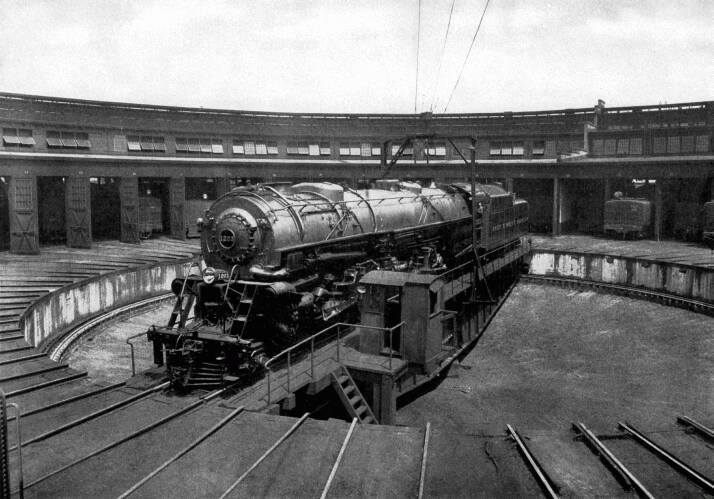 The Roundhouse and the Turntable
The Roundhouse and the Turntable
When the steam locomotive came into use, nearly all wheeled
vehicles were pulled by horses, mules or oxen—mostly horses.
The locomotive was looked upon as a sort of mechanical horse;
hence, it was popularly called the "Iron Horse," just
as in later years the first automobiles were commonly called "horseless
carriages." Today we do not often call the locomotive an
"iron horse," nor do we call the engine-house or roundhouse
in which locomotives are kept a stable, but the places in the
roundhouse where the locomotives are kept are still called "stalls,"
and the roundhouse men who look after the locomotives and take
them in and out of their "stalls" are still called "hostlers."
When a locomotive finishes its run, it is usually taken to
an engine terminal. At the terminal is the roundhouse, where engines
are cleaned and given light or "running" repairs, and
made ready for their next runs. The engine terminal also includes
a coaling station, a water tank, a sand house, an oil house and
an ash pit.
On its arrival at the engine terminal, the engine is taken
to the coaling station to be refueled. Its tank is filled with
water from a tank or column. The sand dome on top of the boiler
is filled with dry sand from the heated sand house. Then, the
engine is moved to the ash pit where the fire-grates are cleaned
and ashes and cinders are removed from under the firebox.
If the engine requires further attention to put it in condition
for the next run, it is taken to the roundhouse. Some engine terminals
have two or three roundhouses, others have only one; some roundhouses
have many stalls; others have only a few, depending upon the number
of engines to be serviced.
The roundhouse is a sort of locomotive garage. Its name is
derived from its shape. Many roundhouses are semi-circular in
shape, many others form a complete circle except for one or two
openings for entrance and exit tracks.
Each locomotive stall is fitted with large doors on the inner
side. There are windows above the doors and also on the outer
side. Each stall bears a number, as shown in the picture.
Long pits between the tracks in the stalls permit inspection
and repair of locomotives from underneath.
Adjacent to or in the roundhouse is a machine and blacksmith
shop. There are also rooms for storing supplies, a tool house,
lockers for the workmen, and a small office for the master mechanic
or foreman in charge of the roundhouse.
One of the most interesting features of the roundhouse is the
turntable, by which locomotives are turned so as to enter or leave
the stalls, or by which locomotives may be turned around.
(Trains, locomotives and cars can also be turned around on
wye tracks, i.e., two tracks leading off from another track, forming
a junction and ending in a single track like the letter Y.)
The turntable is pivoted at the center and is supported at
the ends by wheels which run on a circular track. From the turntable,
tracks spread out fanwise.
When the engine is in position on the turntable, as shown in
the picture, the operator moves the turntable slowly, by means
of an electric or gasoline motor, to a track leading to an empty
stall or to the terminal yard. Small turntables are sometimes
moved by hand. Steam locomotives with tenders measure from 60
to 90 feet or more in length. Turntables must be built to accommodate
the heaviest and longest locomotives employed on the railroad,
or at least on the local division of the railroad. The locomotive
in the picture is one of the largest in the country. Its huge
size can be seen from the size of the man in the cab.
There are many workers at the roundhouse—machinists, boilermakers,
helpers, wipers, and so on. A foreman is in charge. He receives
reports from the locomotive engineers and inspectors on the condition
of the engines and decides what work shall be done on them. At
each engine terminal there is at least one hostler. The hostler
is capable of running the engines. One of his jobs is to drive
the engines in and out of the roundhouse. A hostler is about to
take the engine in the picture out to the track where it will
be placed in readiness for its next trip.
I've Been Working
on the Railroad | Contents Page
|







